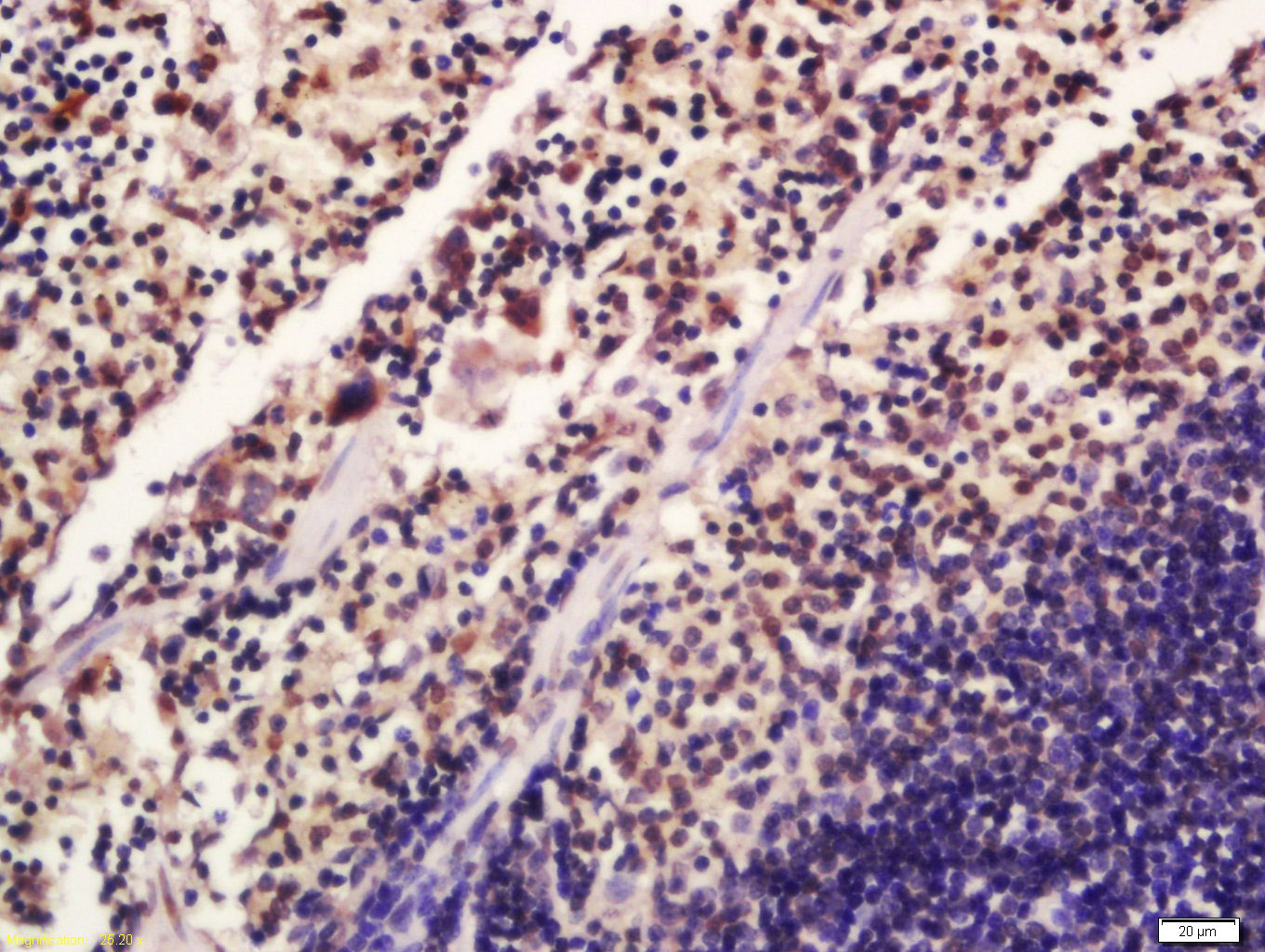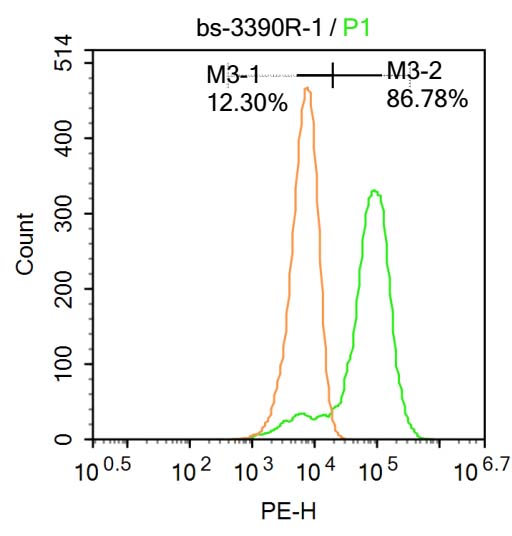
Rabbit Anti-Phospho-SATB1 (Ser47)antibody
DNA binding protein SATB1; DNA-binding protein SATB1; SATB homeobox 1; SATB1; SATB1_HUMAN; Special AT rich sequence binding protein 1 (binds to nuclear matrix/scaffold associating DNA); Special AT rich sequence binding protein 1; Special AT-rich sequence-
View History [Clear]
Details
Product Name Phospho-SATB1 (Ser47) Chinese Name 磷酸化核基质结合区Binding protein1抗体 Alias DNA binding protein SATB1; DNA-binding protein SATB1; SATB homeobox 1; SATB1; SATB1_HUMAN; Special AT rich sequence binding protein 1 (binds to nuclear matrix/scaffold associating DNA); Special AT rich sequence binding protein 1; Special AT-rich sequence-binding protein 1. literatures Product Type Phosphorylated anti Research Area Chromatin and nuclear signals transcriptional regulatory factor Immunogen Species Rabbit Clonality Polyclonal React Species Human, Mouse, (predicted: Chicken, Dog, Pig, Cow, Rabbit, ) Applications ELISA=1:5000-10000 IHC-P=1:100-500 IHC-F=1:100-500 Flow-Cyt=1ug/test IF=1:100-500 (Paraffin sections need antigen repair)
not yet tested in other applications.
optimal dilutions/concentrations should be determined by the end user.Theoretical molecular weight 86kDa Cellular localization The nucleus Form Liquid Concentration 1mg/ml immunogen KLH conjugated Synthesised phosphopeptide derived from human SATB1 around the phosphorylation site of Ser47: LG(p-S)TG Lsotype IgG Purification affinity purified by Protein A Buffer Solution 0.01M TBS(pH7.4) with 1% BSA, 0.03% Proclin300 and 50% Glycerol. Storage Shipped at 4℃. Store at -20 °C for one year. Avoid repeated freeze/thaw cycles. Attention This product as supplied is intended for research use only, not for use in human, therapeutic or diagnostic applications. PubMed PubMed Product Detail SATB1 selectively binds double-stranded, special AT-rich RNA sequences in which 1 strand exclusively consists of well-mixed A, T, and C nucleotides (ATC sequences). It complexes mainly with p300 and this complex can bind to the gp91phox promoter and repress transcriptional activity. Its ability to repress transcription is regulated by nuclear matrix binding. It is expressed predominantly in the thymus.
Function:
Crucial silencing factor contributing to the initiation of X inactivation mediated by Xist RNA that occurs during embryogenesis and in lymphoma (By similarity). Binds to DNA at special AT-rich sequences, the consensus SATB1-binding sequence (CSBS), at nuclear matrix- or scaffold-associated regions. Thought to recognize the sugar-phosphate structure of double-stranded DNA. Transcriptional repressor controlling nuclear and viral gene expression in a phosphorylated and acetylated status-dependent manner, by binding to matrix attachment regions (MARs) of DNA and inducing a local chromatin-loop remodeling. Acts as a docking site for several chromatin remodeling enzymes (e.g. PML at the MHC-I locus) and also by recruiting corepressors (HDACs) or coactivators (HATs) directly to promoters and enhancers. Modulates genes that are essential in the maturation of the immune T-cell CD8SP from thymocytes. Required for the switching of fetal globin species, and beta- and gamma-globin genes regulation during erythroid differentiation. Plays a role in chromatin organization and nuclear architecture during apoptosis. Interacts with the unique region (UR) of cytomegalovirus (CMV). Alu-like motifs and SATB1-binding sites provide a unique chromatin context which seems preferentially targeted by the HIV-1 integration machinery. Moreover, HIV-1 Tat may overcome SATB1-mediated repression of IL2 and IL2RA (interleukin) in T-cells by binding to the same domain than HDAC1. Delineates specific epigenetic modifications at target gene loci, directly up-regulating metastasis-associated genes while down-regulating tumor-suppressor genes. Reprograms chromatin organization and the transcription profiles of breast tumors to promote growth and metastasis.
Subunit:
Interacts (via DNA-binding domains) with CUX1; leading to inhibit the attachment to DNA (By similarity). Homodimer. Part of the nuclear protein complex gamma-globin promoter and enhancer binding factor (gamma-PE) composed at least by SATB1 and HOXB2. Interaction with CtBP1 when not acetylated stabalizes attachment to DNA and promotes transcription repression. Interacts with PCAF. Interacts with sumoylated PML, HDAC1 and HIV-1 Tat via the PDZ-like dimerization domain. Interacts also with DYNLT3 and POLR2J2. Binds to EP300.
Subcellular Location:
Nucleus matrix. Nucleus, PML body. Note=Organized into a cage-like network anchoring loops of heterochromatin and tethering specialized DNA sequences. When sumoylated, localized in promyelocytic leukemia nuclear bodies (PML NBs).
Tissue Specificity:
Expressed predominantly in thymus.
Post-translational modifications:
Sumoylated. Sumoylation promotes cleavage by caspases.
Phosphorylated by PKC. Acetylated by PCAF. Phosphorylated form interacts with HDAC1, but unphosphorylated form interacts with PCAF. DNA binding properties are activated by phosphorylation and inactivated by acetylation. In opposition, gene expression is down-regulated by phosphorylation but up-regulated by acetylation.
Cleaved at Asp-254 by caspase-3 and caspase-6 during T-cell apoptosis in thymus and during B-cell stimulation. The cleaved forms can not dimerize and lose transcription regulation function because of impaired DNA and chromatin association.
Similarity:
Belongs to the CUT homeobox family.
Contains 2 CUT DNA-binding domains.
Contains 1 homeobox DNA-binding domain.
SWISS:
Q01826
Gene ID:
6304
Database links:Entrez Gene: 6304 Human
Entrez Gene: 20230 Mouse
Omim: 602075 Human
SwissProt: Q01826 Human
SwissProt: Q60611 Mouse
Unigene: 517717 Human
Unigene: 311655 Mouse
Product Picture
Antigen retrieval: citrate buffer ( 0.01M, pH 6.0 ), Boiling bathing for 15min; Block endogenous peroxidase by 3% Hydrogen peroxide for 30min; Blocking buffer (normal goat serum,C-0005) at 37℃ for 20 min;
Incubation: Anti-Phospho-SATB1 (Ser47) Polyclonal Antibody, Unconjugated(SL3390R) 1:200, overnight at 4°C, followed by conjugation to the secondary antibody(SP-0023) and DAB(C-0010) staining
Blank control:Molt-4.
Primary Antibody (green line): Rabbit Anti-Phospho-SATB1 (Ser47) antibody (SL3390R)
Dilution: 1μg /10^6 cells;
Isotype Control Antibody (orange line): Rabbit IgG .
Secondary Antibody : Goat anti-rabbit IgG-AF647
Dilution: 1μg /test.
Protocol
The cells were fixed with 4% PFA (10min at room temperature)and then permeabilized with 90% ice-cold methanol for 20 min at-20℃. The cells were then incubated in 5%BSA to block non-specific protein-protein interactions for 30 min at at room temperature .Cells stained with Primary Antibody for 30 min at room temperature. The secondary antibody used for 40 min at room temperature. Acquisition of 20,000 events was performed.
Bought notes(bought amounts latest0)
No one bought this product
User Comment(Total0User Comment Num)
- No comment




 +86 571 56623320
+86 571 56623320
 +86 18668110335
+86 18668110335

